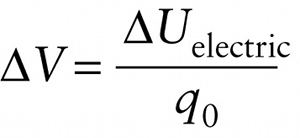Electric potential difference related to electric potential energy difference (17-6)
Question 1 of 3
Question
…equals the change in electric potential energy for a charge q0 moved between these two positions...
{"title":"The difference in electric potential between two positions...","description":"Wrong","type":"incorrect","color":"#99CCFF","code":"[{\"shape\":\"poly\",\"coords\":\"82,133\"},{\"shape\":\"rect\",\"coords\":\"10,16,12,16\"},{\"shape\":\"poly\",\"coords\":\"144,22\"},{\"shape\":\"rect\",\"coords\":\"32,41,73,85\"}]"} {"title":"…equals the change in electric potential energy for a charge q sub 0 moved between these two positions...","description":"Correct!","type":"correct","color":"#ffcc00","code":"[{\"shape\":\"rect\",\"coords\":\"157,6,195,44\"}]"} {"title":"…divided by the charge q sub 0.","description":"Incorrect","type":"incorrect","color":"#333300","code":"[{\"shape\":\"rect\",\"coords\":\"227,24,228,24\"},{\"shape\":\"rect\",\"coords\":\"174,86,204,130\"}]"}Review
For electric potential energy, the value of Uelectric for a charge at a given position is not as important as the potential energy difference ΔUelectric when the charge moves from a point a to a different point b. The same is true for electric potential. From Equation 17-5, the electric potential difference \boldsymbol{\Delta{V}} between two points is

